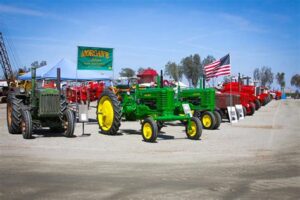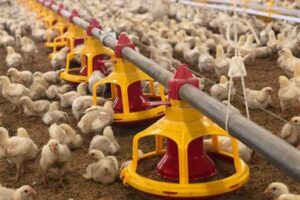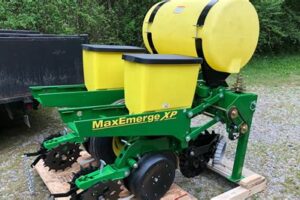Table of Contents
Discover the incredible advancements in farming equipment during the 1800s. Explore how innovative tools revolutionized agriculture, improving efficiency and productivity for farmers. From the invention of the reaper to steam-powered tractors, witness the evolution of 19th-century farming technology and its impact on food production.
During the 1800s, farming equipment underwent a remarkable transformation, revolutionizing the way that agriculture was practiced. From simple hand tools to complex machinery, the advancements made in this era laid the foundation for modern farming practices. With the introduction of steam power and the advent of the Industrial Revolution, farmers were able to increase their productivity and efficiency like never before. As a result, the agricultural industry experienced a significant boom, leading to economic growth and improved living conditions for countless individuals. In this paragraph, we will explore the fascinating world of 1800s farming equipment and delve into the key innovations that shaped the landscape of agriculture.
The Importance of 1800s Farming Equipment
In the 1800s, agriculture played a vital role in the development and sustenance of communities. Farmers relied heavily on various tools and equipment to cultivate the land, plant crops, and harvest their produce. This article explores the different types of farming equipment used during this era and their significance in shaping agricultural practices.
Plows: The Backbone of Farming
One of the most essential farming implements of the 1800s was the plow. These heavy-duty tools were used to break up and turn over the soil, preparing it for planting. Early plows were made of wood, with iron or steel blades attached to the front. As technology advanced, cast-iron plows became more popular due to their durability and efficiency.
Reapers and Binders: Revolutionizing Harvesting
Before the invention of reapers and binders, farmers had to harvest crops by hand, which was labor-intensive and time-consuming. In the late 1800s, mechanical reapers and binders were introduced, revolutionizing the harvesting process. These machines cut and bundled crops such as wheat, oats, and barley, significantly increasing efficiency and reducing manual labor.
Threshing Machines: Separating Grain from Chaff
Threshing machines were another crucial innovation in 1800s farming. These machines separated grain from the chaff, making it easier to process and store crops. Initially, threshing was done manually with flails, but the introduction of threshing machines allowed farmers to complete the task more efficiently, saving time and effort.
Corn Shellers: Streamlining Corn Harvesting
With the increasing demand for corn during the 1800s, corn shellers became essential tools for farmers. These machines removed the kernels from dried corn cobs, streamlining the harvesting process. Corn shellers were typically operated by hand or driven by horses, allowing farmers to efficiently process large quantities of corn.
Horse-Drawn Cultivators: Improving Weed Control
Weed control was a constant challenge for farmers in the 1800s. Horse-drawn cultivators were introduced to help combat this issue. These implements were dragged along the soil, removing weeds and loosening the top layer to promote healthy crop growth. Cultivators made it easier for farmers to maintain weed-free fields and improve overall productivity.
Seed Drills: Precise Planting
Prior to the introduction of seed drills, planting seeds was done by hand, making it difficult to achieve uniform spacing and depth. Seed drills allowed farmers to plant seeds with precision and efficiency. These machines sowed seeds at a consistent depth and spacing, resulting in improved crop yields and reduced seed wastage.
Hay Balers: Revolutionizing Hay Production
Hay balers were a game-changer for farmers in the 1800s as they transformed the labor-intensive task of producing hay. These machines compressed cut hay into tightly bound bales, making it easier to store and transport. Hay balers significantly increased efficiency and reduced the amount of manual labor required for hay production.
Steam Tractors: The Dawn of Mechanization
Steam tractors marked a significant shift towards mechanization in farming during the late 1800s. These powerful machines were used for plowing, threshing, and other heavy-duty tasks. Steam tractors increased productivity and reduced the reliance on animal power, paving the way for modern agriculture as we know it today.
Conclusion: The Evolution of Farming Equipment
The 1800s witnessed remarkable advancements in farming equipment that revolutionized agricultural practices. From plows and reapers to seed drills and steam tractors, these tools played a crucial role in increasing productivity, reducing labor, and shaping the future of farming. Today, we owe much of our modern agricultural efficiency to the innovations of the 1800s.
Advances in Plowing Technology
In the 1800s, innovative plowing equipment transformed the agricultural landscape. Horse-drawn plows, such as the cast-iron moldboard plow, became widely used, greatly reducing the physical labor involved in tilling the soil. These advancements led to increased efficiency, allowing farmers to cultivate larger areas of land and improve crop yields.
The Revolution of Reaper-Binders
The introduction of reaper-binders revolutionized harvesting in the 1800s. These machines combined the tasks of reaping, binding, and threshing grain, drastically reducing the time and effort required to gather crops. With the mechanical assistance provided by reaper-binders, farmers were able to increase their productivity and meet the growing demands of the expanding population.
The Rise of the Steam-Powered Threshing Machine
Steam-powered threshing machines played a pivotal role in the evolution of farming equipment during the 1800s. These massive devices, usually operated by steam engines, utilized revolving cylinders and mechanical separators to separate grain from straw. The adoption of steam-powered threshing machines significantly accelerated the threshing process, enabling farmers to handle larger volumes of harvested crops more efficiently.
The Advent of Seed Drills
The development of seed drills in the 1800s revolutionized the way seeds were sown. These machines allowed farmers to plant seeds at precise depths and intervals, ensuring optimal spacing and increasing crop uniformity. By mechanizing the process, seed drills eliminated much of the manual labor involved in sowing and helped farmers maximize the potential of their fields.
The Impact of Steam-Powered Plowing Engines
Steam-powered plowing engines were a game-changer in the 1800s, assisting farmers with the heaviest and most labor-intensive tasks. These engines, often equipped with traction wheels and steel plows, could plow large areas of land at impressive speeds, surpassing the capabilities of traditional horse-drawn equipment. By harnessing the power of steam, farmers could cultivate vast stretches of land more efficiently than ever before.
The Evolution of Corn Harvesting Equipment
The 1800s witnessed significant advancements in corn harvesting equipment, facilitating the cultivation of this staple crop. Hand-held corn shellers were gradually replaced by mechanical corn shellers, considerably reducing the labor required to remove the kernels from the cobs. Additionally, corn binders were introduced, automating the process of cutting and binding cornstalks, further boosting productivity.
The Introduction of Horse-Drawn Cultivators
Horse-drawn cultivators emerged in the 1800s as a vital tool in weed control and soil preparation. These implements featured multiple metal blades or teeth, which could be adjusted to various depths to effectively uproot weeds and loosen the soil. By reducing competition for nutrients and aerating the earth, horse-drawn cultivators played a crucial role in enhancing crop quality and yields.
The Rise of Grain Elevators
Grain elevators emerged as essential components of farming infrastructure in the 1800s. These tall storage structures, equipped with conveyor systems, enabled farmers to store and handle large quantities of harvested grain efficiently. By minimizing spoilage and facilitating the movement of grain, grain elevators revolutionized the storage and distribution of agricultural produce, ensuring better prices for farmers and reliable food supplies for growing populations.
In the 1800s, farming equipment underwent a significant transformation, revolutionizing agricultural practices and marking a turning point in the history of farming. The introduction of new machinery not only increased productivity but also made farming more efficient and less labor-intensive. Here, we will explore the benefits and impact of 1800s farming equipment from a professional perspective.
1. Increased productivity:
- The advent of machinery such as the reaper and thresher allowed farmers to significantly increase their productivity. Manual harvesting and threshing were time-consuming and required a large workforce. With the help of these machines, farmers could harvest and process crops faster, enabling them to handle larger acreages and meet growing demands.
- The development of the steam engine-powered machines, like the steam tractor, further enhanced productivity by replacing animal power with mechanical power. This allowed for greater control, speed, and efficiency in plowing, planting, and other essential farming tasks.
2. Reduced labor requirements:
- Prior to the introduction of farming equipment, agriculture heavily relied on manual labor. The use of machinery significantly reduced the need for human workers, freeing up labor for other sectors of the economy.
- This shift also led to the migration of people from rural areas to urban centers, fueling industrialization and urbanization. Consequently, it contributed to the growth of cities and the diversification of employment opportunities.
3. Improved crop quality and yield:
- Farming equipment enabled farmers to cultivate larger areas of land efficiently, resulting in increased crop yields.
- The mechanization of processes, such as planting and fertilizing, ensured more precise and uniform distribution, leading to improved crop quality and higher yields.
- Furthermore, the ability to remove weeds mechanically through implements like the horse-drawn cultivator reduced competition for resources, allowing crops to grow more vigorously and produce better yields.
4. Technological advancements:
- The introduction of new farming equipment in the 1800s paved the way for ongoing technological advancements in agriculture.
- As farmers witnessed the benefits of mechanization, they became more open to adopting innovative farming techniques and machinery. This led to a continuous cycle of improvement and innovation that still persists today.
- Moreover, the increased demand for agricultural machinery stimulated research and development, resulting in further advancements in farming technology.
In conclusion, the introduction of farming equipment in the 1800s revolutionized agricultural practices, increasing productivity, reducing labor requirements, improving crop quality, and stimulating technological advancements. These developments not only transformed the farming industry but also played a crucial role in shaping the socio-economic landscape of the time.
Thank you for taking the time to visit our blog and learn about farming equipment in the 1800s. We hope that this article has provided you with valuable insights into the tools and machinery that were instrumental in shaping the agricultural landscape of that era. From primitive hand tools to more advanced inventions, farmers in the 1800s relied on these equipment to cultivate their land and improve their productivity.
As you have read, the 1800s marked a period of significant advancements in farming technology. The introduction of the steel plow, for example, revolutionized the way farmers tilled their soil, making it easier to break through tough prairie sod. This innovation, along with the development of other tools such as the reaper and the threshing machine, allowed farmers to work more efficiently and increase their crop yields. The use of horse-drawn machinery, which replaced manual labor, further accelerated the farming process.
It is important to acknowledge the hardships faced by farmers during this time. They had to endure long hours of labor in often harsh conditions, without the modern conveniences we enjoy today. Yet, their resilience and dedication to their craft paved the way for the agricultural practices we see today. By understanding the challenges they faced and the equipment they used, we gain a deeper appreciation for the progress that has been made over the years.
We hope that this article has sparked your interest in the fascinating world of 1800s farming equipment. If you would like to delve deeper into this topic, we encourage you to explore our other blog posts, where we dive into specific types of machinery and their impact on agriculture. Feel free to leave any comments or questions you may have, and we will be more than happy to engage in a discussion with you.
Once again, thank you for visiting our blog. We hope to see you again soon as we continue to explore the rich history of farming equipment and its role in shaping our world.
Video 1800s Farming Equipment
Here are some common questions people also ask about 1800s Farming Equipment:
What were the most common types of farming equipment used in the 1800s?
In the 1800s, some of the most common types of farming equipment included the plow, grain cradle, scythe, threshing machine, and horse-drawn reaper. These tools helped farmers to cultivate the land, harvest crops, and process grain more efficiently.
How did 1800s farming equipment differ from earlier tools?
Compared to earlier tools, 1800s farming equipment saw significant advancements in terms of efficiency and effectiveness. For example, the introduction of horse-drawn machinery reduced the reliance on manual labor and increased productivity. Additionally, improvements in design and materials made the equipment sturdier and more durable.
Why were horse-drawn machines widely used in 1800s farming?
Horse-drawn machines gained popularity in 1800s farming due to their ability to perform tasks quickly and effectively. They allowed farmers to cover larger areas of land and complete tasks such as plowing, harvesting, and threshing with greater efficiency. The use of horses also reduced the physical strain on farmers.
How did the invention of the threshing machine impact farming in the 1800s?
The invention of the threshing machine revolutionized farming in the 1800s. It automated the process of separating grain from the chaff, which was previously a labor-intensive task done by hand. The threshing machine significantly increased the speed and efficiency of grain processing, saving farmers valuable time and effort.
What challenges did farmers face when using 1800s farming equipment?
Farmers using 1800s farming equipment faced various challenges. The maintenance and repair of machinery were often time-consuming and required specialized knowledge. Additionally, the reliance on weather conditions and the availability of horses for power posed logistical difficulties. Furthermore, the initial cost of purchasing equipment could be a significant financial burden for many farmers.
Remember, understanding the historical context and technological limitations of 1800s farming equipment is crucial to appreciating the advancements made in modern agriculture.






